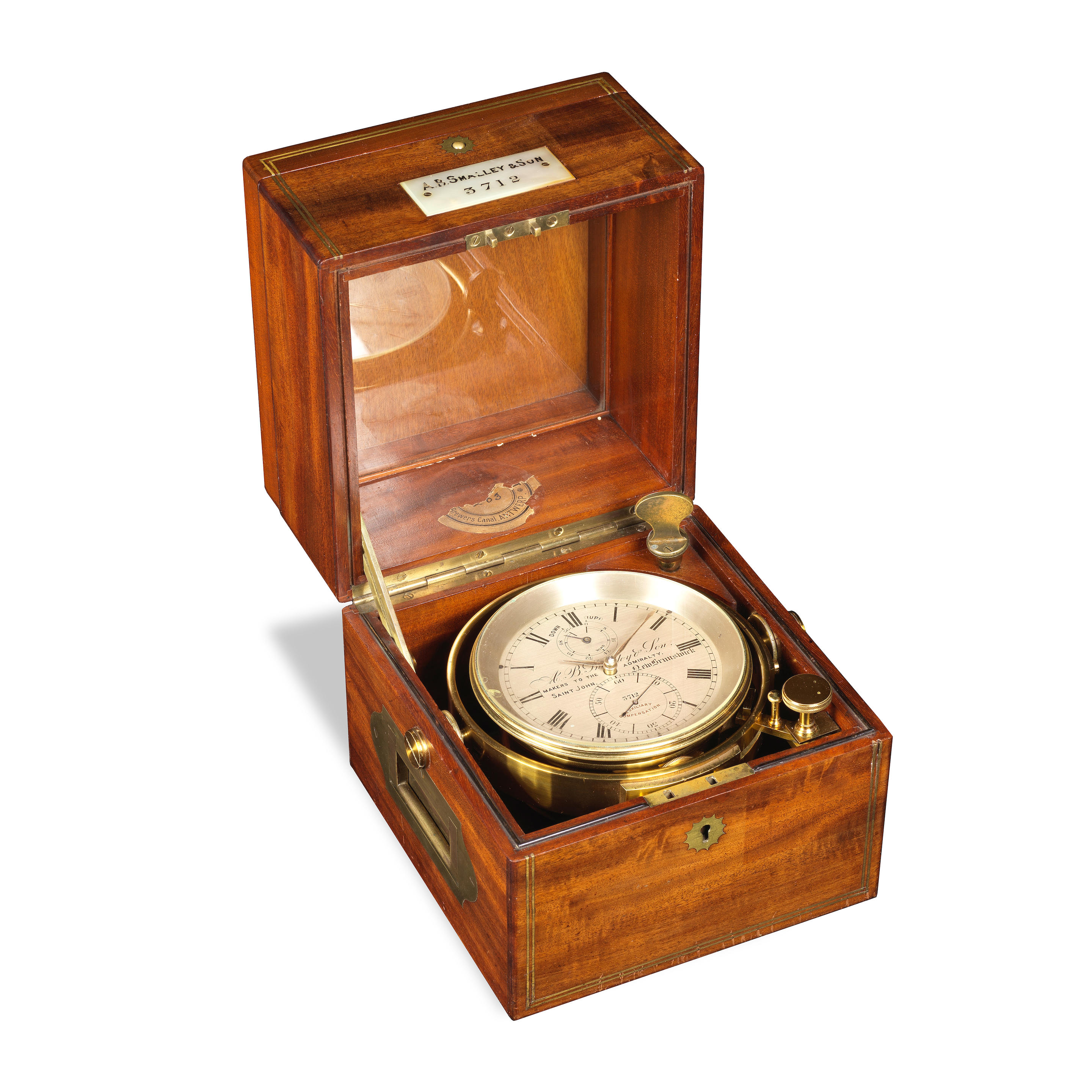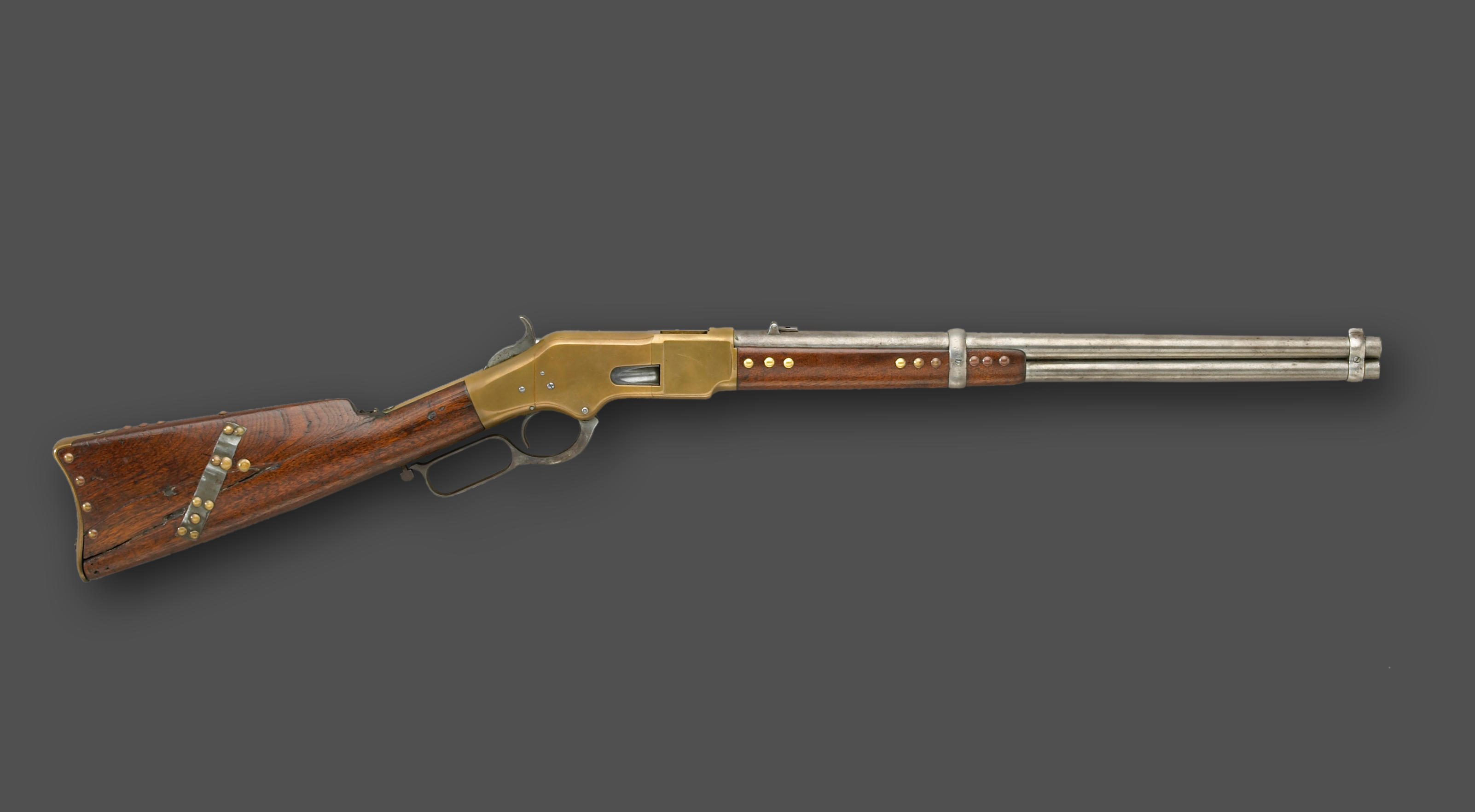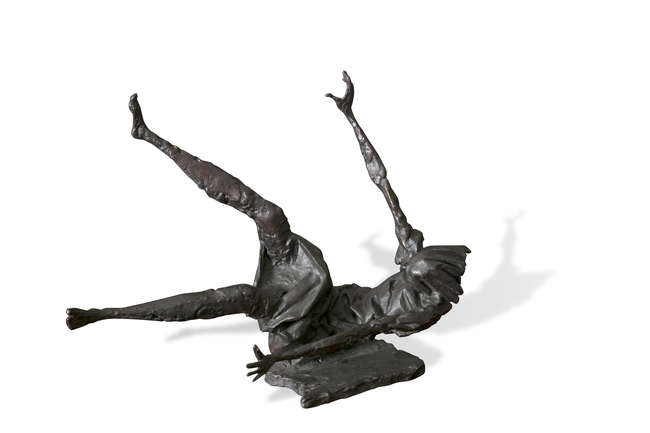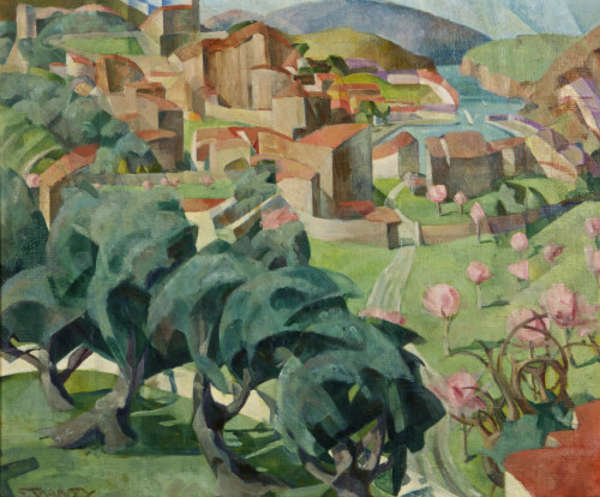HISTORIC INTEREST: an exhibition silver and gilt electrotype clockthe case designed by John Bell (1811-1895) for Elkington Mason & Co, Birmingham 1853, stamped 'ELECTRO DEPOSITED & PUBLISHED BY ELKINGTON MASON & CO APRIL 1853'
Shaped triangular sculptural form, highly decorative the 'Hours Clock-Case', the whole embellished in silver-plate and gilding, the apex crowned with a figure of Psyche, winged and looking upward, emblematic of eternity, stylised sunrays and clouds beneath her feet, the case front embellished with a dramatic bas-relief, sinuous classical figures representing the twelve hours are cast encircling the enamelled clock dial, to the base are two further figures symbolising 'Night', a woman in repose, and 'Morning', a man waking, rocky outcrops beneath them, the reverse encasing a brass twin train clock movement with outside count wheel striking on a bell, includes pendulum and two winders, all raised on three ball feet, width 29cm, height 40cm.FootnotesProvenance
Exhibited at the 'Paris Universal Exhibition' of 1855 - see the 'Illustrated London News' from 17th November, 1855, p.592.
Lot Essay
The prototype of this sculptural clock, designed by John Bell (1811-1895) for Elkington Mason & Co in Birmingham, was first exhibited at the 'Great Exhibition' of 1851. This landmark exhibition was probably the most successful, memorable and influential cultural event of the 19th century. From May to October 1851, the magnificent Crystal Palace in Hyde Park, London, was filled with visitors to the 'Great Exhibition of the Works of Industry of All Nations'. The exhibition's phenomenal success confounded the predictions of its many doubters in both parliament and the press. Visited by over six million people (equivalent to a third of the British population at that date), it generated a vast profit of £186,000.
The 1851 exhibition was the first ever international exhibition of manufactured products. It inspired a long succession of international fairs in other cities, including Paris, Dublin, New York, Vienna and Chicago – almost one a year for the rest of the 19th century.
As discussed and illustrated in the 'Exhibition Supplement to The Illustrated London News', published on August 9th 1851, p.188, this fine Elkington clock-case comes 'within the scope of legitimate sculpturesque decoration of a work of utility. It is styled the "Hours Clock-Case" ... it is prettily conceived, and pleasingly designed; though it might, perhaps, be improved in subsequent copies ...' The commentator then goes on to list the improvements they feel would enhance John Bell's original design. It is therefore interesting to note that the clock-case on offer here is the new and improved version, which takes on board the criticisms cited in 1851, and was subsequently displayed at the 'Exposition Universelle' in Paris (otherwise known as the 'Paris Universal Exhibition'), in 1855.
As per the description and text quoted in 'The Illustrated London News' dated November 17th 1855, p.595, under the heading 'The Paris Universal Exhibition', it states; 'We have engraved three of the beautiful works of British Art which have been attractive even in the Art-Capital of Paris ... Next is a Clock Case, designed by John Bell and manufactured and exhibited by Messrs Elkington Mason and Co. The dial is encircled with figures of the twelve hours; and at the base are figures of Night and Morning. The design is more in the French taste than Mr Bell's compositions usually are ...' It is therefore apparent that this lot currently on offer, was exhibited at the 1855 'Exposition Universelle' in Paris, which took place on the Champs-Elysees from 15 May to 15th November, in 1855. Its official title was the 'Exposition Universelle des Produits de l'Agriculture, de l'Industrie et des Beaux-Arts de Paris 1855'. Held at the height of the Crimean War, the spectacle was the Second French Empire's attempt to surpass London's Great Exhibition of 1851.
In considering the interconnection of industry and industrial display with sculpture in mid-nineteenth century Britain, the name of one sculptor in particular stands out. During the 1850s, John Bell was Britain's foremost sculptor, modelling for manufacturers of earthenware and metal statuary. A prominent exhibitor and curator of sculpture displays in the international exhibitions, Bell was the chief sculptor associated with Henry Cole's design reform movement and a prolific lecturer on sculpture. At the same time, Bell successfully maintained a conventional sculpture workshop, producing marble and bronze statues for private collections and national monuments. At the international exhibitions, Bell's designs could be found embodied in statues in marble, plaster, Parian, cast iron and electrotyped bronze, as well as silver-plated clocks and tableware. Bell therefore was prominently positioned at the centre of the nexus between fine art and industry during the 1850s. Whilst Bell's work as a modeller featured prolifically throughout the industrial displays at the early international exhibitions, he also curated displays of 'fine art' sculpture.
Therefore the teaming up of John Bell and Elkington Mason & Co was a match made in creative and industrial heaven - fine art and industry combined. From 1836, Elkington were the pioneering British electroplating company who had invented, patented and developed the key elements of the art of electro-metallurgy. They were the world's pre-eminent art-metalwork manufacturer's of the 19th century, harnessing the power of electricity for the creation of artworks and mass consumer goods. Critically acclaimed at the Great Exhibition of 1851, Elkington became one of the world's first multinational brand identities and luxury trademarks. It was the only British company to consistently win the highest awards at all seven of the international exhibitions held from 1851-1878. The history of Elkington's achievements is the great, untold British success story of the Victorian era.
Literature
Alistair Grant - Sculpture, Metalwork, Ceramics and Glass V&A Museum, 'Elkington & Co. Visitors' Book, 1855-1878', accessed via https://www.vam.ac.uk/blog/projects/elkington-co-visitors-book-1855-1878 17/1/24
Christopher Marsden - senior archivist Victoria and Albert Museum, 'The Gazette Official Public Record', accessed via https://www.thegazette.co.uk/all-notices/content/100717, 17/1/24
Gabriel Williams, 'Industry and the ideal - ideal sculpture and reproduction at the early international exhibitions - two volumes', Volume 1, PhD thesis University of York, History of Art, September 2014
HISTORIC INTEREST: an exhibition silver and gilt electrotype clockthe case designed by John Bell (1811-1895) for Elkington Mason & Co, Birmingham 1853, stamped 'ELECTRO DEPOSITED & PUBLISHED BY ELKINGTON MASON & CO APRIL 1853'
Shaped triangular sculptural form, highly decorative the 'Hours Clock-Case', the whole embellished in silver-plate and gilding, the apex crowned with a figure of Psyche, winged and looking upward, emblematic of eternity, stylised sunrays and clouds beneath her feet, the case front embellished with a dramatic bas-relief, sinuous classical figures representing the twelve hours are cast encircling the enamelled clock dial, to the base are two further figures symbolising 'Night', a woman in repose, and 'Morning', a man waking, rocky outcrops beneath them, the reverse encasing a brass twin train clock movement with outside count wheel striking on a bell, includes pendulum and two winders, all raised on three ball feet, width 29cm, height 40cm.FootnotesProvenance
Exhibited at the 'Paris Universal Exhibition' of 1855 - see the 'Illustrated London News' from 17th November, 1855, p.592.
Lot Essay
The prototype of this sculptural clock, designed by John Bell (1811-1895) for Elkington Mason & Co in Birmingham, was first exhibited at the 'Great Exhibition' of 1851. This landmark exhibition was probably the most successful, memorable and influential cultural event of the 19th century. From May to October 1851, the magnificent Crystal Palace in Hyde Park, London, was filled with visitors to the 'Great Exhibition of the Works of Industry of All Nations'. The exhibition's phenomenal success confounded the predictions of its many doubters in both parliament and the press. Visited by over six million people (equivalent to a third of the British population at that date), it generated a vast profit of £186,000.
The 1851 exhibition was the first ever international exhibition of manufactured products. It inspired a long succession of international fairs in other cities, including Paris, Dublin, New York, Vienna and Chicago – almost one a year for the rest of the 19th century.
As discussed and illustrated in the 'Exhibition Supplement to The Illustrated London News', published on August 9th 1851, p.188, this fine Elkington clock-case comes 'within the scope of legitimate sculpturesque decoration of a work of utility. It is styled the "Hours Clock-Case" ... it is prettily conceived, and pleasingly designed; though it might, perhaps, be improved in subsequent copies ...' The commentator then goes on to list the improvements they feel would enhance John Bell's original design. It is therefore interesting to note that the clock-case on offer here is the new and improved version, which takes on board the criticisms cited in 1851, and was subsequently displayed at the 'Exposition Universelle' in Paris (otherwise known as the 'Paris Universal Exhibition'), in 1855.
As per the description and text quoted in 'The Illustrated London News' dated November 17th 1855, p.595, under the heading 'The Paris Universal Exhibition', it states; 'We have engraved three of the beautiful works of British Art which have been attractive even in the Art-Capital of Paris ... Next is a Clock Case, designed by John Bell and manufactured and exhibited by Messrs Elkington Mason and Co. The dial is encircled with figures of the twelve hours; and at the base are figures of Night and Morning. The design is more in the French taste than Mr Bell's compositions usually are ...' It is therefore apparent that this lot currently on offer, was exhibited at the 1855 'Exposition Universelle' in Paris, which took place on the Champs-Elysees from 15 May to 15th November, in 1855. Its official title was the 'Exposition Universelle des Produits de l'Agriculture, de l'Industrie et des Beaux-Arts de Paris 1855'. Held at the height of the Crimean War, the spectacle was the Second French Empire's attempt to surpass London's Great Exhibition of 1851.
In considering the interconnection of industry and industrial display with sculpture in mid-nineteenth century Britain, the name of one sculptor in particular stands out. During the 1850s, John Bell was Britain's foremost sculptor, modelling for manufacturers of earthenware and metal statuary. A prominent exhibitor and curator of sculpture displays in the international exhibitions, Bell was the chief sculptor associated with Henry Cole's design reform movement and a prolific lecturer on sculpture. At the same time, Bell successfully maintained a conventional sculpture workshop, producing marble and bronze statues for private collections and national monuments. At the international exhibitions, Bell's designs could be found embodied in statues in marble, plaster, Parian, cast iron and electrotyped bronze, as well as silver-plated clocks and tableware. Bell therefore was prominently positioned at the centre of the nexus between fine art and industry during the 1850s. Whilst Bell's work as a modeller featured prolifically throughout the industrial displays at the early international exhibitions, he also curated displays of 'fine art' sculpture.
Therefore the teaming up of John Bell and Elkington Mason & Co was a match made in creative and industrial heaven - fine art and industry combined. From 1836, Elkington were the pioneering British electroplating company who had invented, patented and developed the key elements of the art of electro-metallurgy. They were the world's pre-eminent art-metalwork manufacturer's of the 19th century, harnessing the power of electricity for the creation of artworks and mass consumer goods. Critically acclaimed at the Great Exhibition of 1851, Elkington became one of the world's first multinational brand identities and luxury trademarks. It was the only British company to consistently win the highest awards at all seven of the international exhibitions held from 1851-1878. The history of Elkington's achievements is the great, untold British success story of the Victorian era.
Literature
Alistair Grant - Sculpture, Metalwork, Ceramics and Glass V&A Museum, 'Elkington & Co. Visitors' Book, 1855-1878', accessed via https://www.vam.ac.uk/blog/projects/elkington-co-visitors-book-1855-1878 17/1/24
Christopher Marsden - senior archivist Victoria and Albert Museum, 'The Gazette Official Public Record', accessed via https://www.thegazette.co.uk/all-notices/content/100717, 17/1/24
Gabriel Williams, 'Industry and the ideal - ideal sculpture and reproduction at the early international exhibitions - two volumes', Volume 1, PhD thesis University of York, History of Art, September 2014















Testen Sie LotSearch und seine Premium-Features 7 Tage - ohne Kosten!
Lassen Sie sich automatisch über neue Objekte in kommenden Auktionen benachrichtigen.
Suchauftrag anlegen